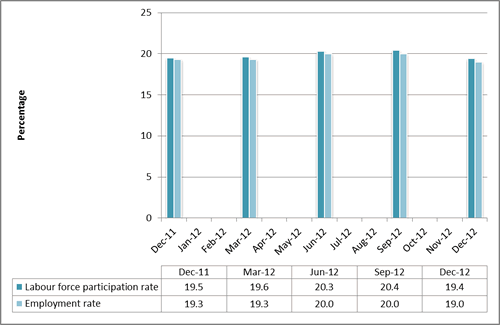Indicator 12: Labour force participation
| Indicator is fully reported? | Yes; data that is not already published is available on request. |
| Type of indicator |  Outcome indicator Outcome indicator |
| Other relevant indicators |
|
| Our findings |
When older people are employed, their employment brings social and financial benefits to society, to industry and business, and to the older people. The ageing population means that employing older workers is increasingly important to economic development. The workforce participation of older people has increased since 1986. Definitions Labour-force participation calculates the number of people who are working or available for work.[2] The employment rate is the number of people employed as a percentage of the working-age population.[3] Quarterly data Statistics New Zealand publishes quarterly information from the Household Labour Force Survey.[4] Figure 1 shows the rates of labour-force participation for people aged 65+ and employment rate for people aged 65+, using data from the December 2012 report. It shows that the rates from December 2011 to December 2012 were within 1%. Longer-term trends The Ministry of Social Development reports on its indicator at www.msd.govt.nz/what-we-can-do/seniorcitizens/positive-ageing/progress/elimination-of-ageism-and-the-promotion-of-flexible-work.html, using data from the Household Labour Force Survey. The current report shows that the employment rate for people aged 65+ increased from about 8.5% in 1996 to 17% in 2010. Census data allows longer-term trends to be identified. This data can be reported by age, sex, and ethnicity. In 2009, Statistics NZ published a study called Labour force participation of New Zealanders aged 65 years and over, 1986-2006.[5] There are plans to update the report after the 2013 census. Key trend data from the 2009 report is that for people aged 65+:
|
| How entities use the data |
Statistics NZ used data collected from the census to publish information on trends in labour-force participation. Publications are updated after each census. This provides public entities and the private sector with useful information for policy development and planning. An example of how the data can be used is a 2010 report published by the Department of Labour – now part of the Ministry of Business, Innovation and Employment – called Labour force participation in New Zealand: Recent trends, future scenarios, and the impact on economic growth in 2010.[10] A chapter in the report focuses on the ageing population.[11] |
| Entity responsible for this indicator | Statistics New Zealand |
Figure 1: Labour-force participation rate and employment rate, for people aged 65+, December 2011 to December 2012

Source: Table 4 of the data tables for the December 2012 quarter, www.stats.govt.nz/browse_for_stats/income-and-work/employment_and_unemployment/HouseholdLabourForceSurvey_HOTPDec12qtr.aspx.
[1] The New Zealand Positive Ageing Strategy (2001) is available at www.msd.govt.nz/what-we-can-do/seniorcitizens/positive-ageing/strategy/index.html.
[2] http://www.stats.govt.nz/browse_for_stats/income-and-work.aspx/.
[3] www.stats.govt.nz/browse_for_stats/income-and-work/employment_and_unemployment/employment-rate-article.aspx.
[4] www.stats.govt.nz/browse_for_stats/income-and-work/employment_and_unemployment/household-labour-force-survey-info-releases.aspx. Data by age and sex is available on Infoshare.
[5] www.stats.govt.nz/browse_for_stats/income-and-work/employment_and_unemployment/labour-force-participation-aged-65-plus-1986-2006.aspx.
[10] dol.govt.nz/publications/lmr/participation/summary/.
[11] dol.govt.nz/publications/lmr/participation/participation_06.asp.

